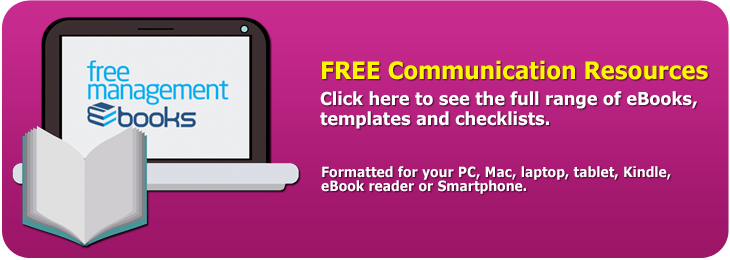Effective Communications - Free eBook in PDF Format
 |
 |
|
Book Description - ISBN 978-1-62620-962-6 (45 Pages)
Strong communication skills are arguably the most important attribute a manager can possess. This free eBook explains the basic principles of communication so that you can create an open and honest communications environment in any situation.
Chapter 1 - Effective Communication in the Workplace
The ability to communicate is an essential life skill and one that can be continually developed. Individuals who are good communicators find it easy to develop empathy and trust with others. These people adapt their style of communication to suit the audience and situation they are presented with.
Chapter 2 - Workplace Communication Styles
Each person's communication style is a unique combination of their own innate skills and those learned both formally and through experience. What makes some people better than others at communicating is their ability to adapt their style to suit the message, environment, and exchange.
Chapter 3 - Recognizing Workplace Communication Styles
Whilst individuals may favor a particular way of communicating, they can alter their behavior to other communication styles if necessary to suit a particular situation. This flexibility helps them to come across as knowledgeable, confident, and empathetic.
Chapter 4 - Perceptual Preferences
People may be naturally visual, auditory, or kinesthetic communicators. Using a supplementary form of communication can help your message to be correctly interpreted.
Chapter 5 - Attitudes to Communications
Effective communication depends on your ability to read the attitude of the other person or group. This is something that can be picked up from the behavior you see and will reflect their emotions and feelings towards the communication.
Chapter 6 - Communication Research
There is a whole industry built on helping you to become a better communicator. Unfortunately, some of what is written about this topic is rather misleading.
Chapter 7 - Using the RESULT Principle
The RESULT principle can help you to improve your communication skills. The acronym stands for Reason, Environment, Specific, Understanding, Listen, and Timeframe.
Chapter 8 - Barriers to Communication
Problems with communication occur when the way in which we express ourselves is not fully understood and appreciated by those we want to communicate with. Some of these differences are within our control, others are not, and being forewarned about such obstacles influences how successful your communications will be.
| You will learn how to: |
|
![]()
![]()
I can highly recommend this book
It pretty much goes without saying that communication is one of the most important skills to have in business - or in life in general. This book on Effective Communications caught my eye because I am always excited to improve my professional performance. I think it is important to get better each and every day, so reading this short book provided me with an opportunity to improve my understanding of basic communications techniques and elements. In the end, I came away pleased with having spent some time reading this book. While not all of the information was new to me, it was well-presented and did offer me some points to take away and think about.
Surprisingly, one of the most memorable elements of the book comes right away in the introduction. The book makes a point of defining successful communication as when everyone involved comes away understanding the same thing. That is a simple definition, and one that I had not thought about before. When you have a clear understanding of the goal (i.e. making sure everyone understands the same thing), the process of communication suddenly seems a little simpler.
The 'Communications Styles' section was another that I enjoyed, because I find value in thinking critically about what I do and how it can be improved. I was able to see myself in some of the examples that are offered, and came away with a better understanding of my general communication style. Just being self-aware in that way is a big step in the right direction toward more effective and efficient communication.
In the same vein, the 'Attitudes to Communications' section was an eye-opener in terms of how different attitudes and personalities can affect how communication works. Not only was I able to perceive myself in these different attitudes, but also those around me. With an understanding of different attitudes and what they mean, I feel better prepared to deal with a range of different people and still communicate effectively with each of them.
The only section of this book that I wasn't very interested in was the section called 'Communication Research'. I'm sure the content contained within can be valuable to some, but I found myself drifting while reading this section and not drawing much constructive from it. I would recommend still reading this section for yourself as the content might be more relevant for you than it was for me.
'Communication Barriers' toward the end of the book was a section that I found interesting to read and informative at the same time. Each of the five barriers to communication that are addressed I found relevant to my experience in some way. The discussion of each of these points and the examples provided helped me gain an understanding for how to potentially sidestep some of these problems down the road.
Overall, I can highly recommend this book on effective communication as a building block for your professional skill set. In fact, I feel like the points within this book will even help me communicate more effectively in my personal life as well. Communicating more effectively is something that everyone can benefit from, and this book will only take a short amount of your time to read.
Ollie Lorrimer
Worth reading even if you are already a confident communicator
For the longest time I have equated communicating with being able to speak with people in both personal and professional settings. I have been blessed with the gift of gab and as such, fancied myself as quite the communicator. After a recent promotion at work, I have been encouraged to work on my professional communication skills and as part of the process I have read this guide to effective communications. Upon doing so, I have realized there is a distinct difference between being a good speaker and being a good communicator.
One of the first thinks that caught my attention in this book was the importance of listening. I am certain that is where many people fail as communicators and I hope to avoid that pitfall myself, so if you take nothing else from this book, learn to be an active and honest listener. Aside from listen I found this guide to provide good insight into the styles of communicating and how to determine which one is best for you. The primary methods of communicating discussed in the book are active, logical, connector, thinker, and combiner. The book does a good job of clearly and simply defining each of these methods in an easy to follow chart and if nothing else, you should look over that section.
In addition to the methods of communicating, you will also learn about the attitudes of communication which are passive, passive aggressive, aggressive, and assertive, each of which has its pros and cons. Mehrabian's rule of the "3 v's" is another unique topic covered and contrary to mainstream belief in shows that non-verbal cues are not more important that spoken words. This theory has apparently been misquoted numerous times leading to the confusion. If for no other reason, I would suggest reading the book to learn the truth about Mehrabian's theory, one that has held true for over 40 years now.
Another area of particular interest for me was the section outlining the importance of Para-verbal signals which include things such as tone, speed, and emphasis. When you correctly Para-verbal signals can change the complete meaning of a statement and leave a meaningful impact on the listener. Written Para-verbal signals of the other hand include things like punctuation, layout, and grammar. Each of those items can also completely change the meaning of a sentence and should not be overlooked.
Lastly, I found the RESULT communication principle to be particularly interesting. RESULT is an acronym for reason, environment, specific, understanding, listen, and time frame. Reason is of course the purpose for your communication. Environment takes into account the specifics of whom and where you will communicate. Specific is the reason for your communications; what do you want to achieve?
Understanding as you can imagine is arguably the most important part and is where you must ensure the listener understands what you need from them. A common theme among communication, the listen portion refers to you being an active listener and the time frame is making reference to how long you have to make the needed communication. Overall, I found the RESULT principle to be simple and effective, certainly one of the best parts of this book for me. The final section of this book looks at some common barriers to communication and the best ways to identify and avoid them. Overall a good read but some sections are redundant, still worth reading in my opinion though.
Sarah Brewer


